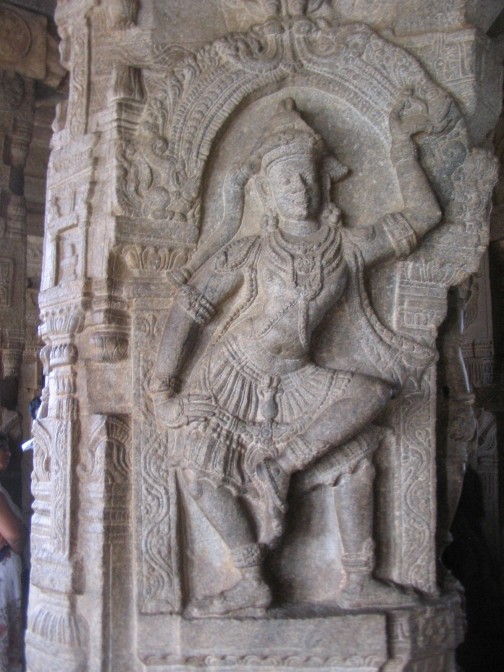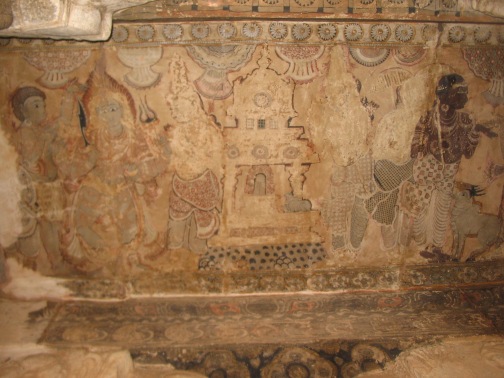Recently the In-laws and nephew, Gana, were at our place for the kiddo’s summer holidays. Since we didn’t want to go around to any of the malls (again), we decided to do out of Bangalore for a day trip. This would ensure that everyone got to see something new, and not make it very strenuous for the nephew and In-laws.
After a lot of deliberation, we finally zeroed on Lepakshi. However, the place didnt warrant an entire day, so we decided to combine it with Nandi Hills, timed so that we could catch the sunset. While most sites advised to catch the sunrise, considering we had a small kid in tow, we changed our plan.
Another consideration was that there are no restaurants at Lepakshi. As advised by various travel sites and blogs, we decided to leave a little late, after packing a hearty, and easily transportable lunch for everyone.
A bit about Lepakshi:
Lepakshi is a small village in Anantpur District of Andhra Pradesh. It is about 120kms from Bangalore. It is famous for its 16th century temple of Lord Veerabhadra, Siva and Vishnu. The temple of Lord Veerabhadra is built on a hill called Kurmasailam, meaning tortoise hill in Telugu after the shape of the hill.
There are a couple of stories regarding to the origin of the name “Lepakshi”. One of them traces the name to The Ramayana. It is said to refer to the place where the bird Jatayu fell. Jatayu had been injured after a fight with Ravana while he was abducting Sita. When Rama found him lying on the ground, he cried out in distress “le pakshi!” (rise, bird!)
Another, slight gruesome story is that the treasurer of the Vijayanagar empire, Virupanna, built the temple in the emperor’s absence. On his return, the furious emperor ordered Virupanna’s eye to be put out. On hearing the order, Virupanna himself took out his eyes, and hence the name ” Lepa Akshi”.
The Trip:
We finally left at 9am, and by the time we left the city it was almost 10 am. The route we took was the Outer Ring Road joining into NH7 Bangalore-Hyderabad highway.
Once we crossed Chikballapur, we came across Kamat Upachar. we stopped here for refreshing coffee and steaming hot puris. it also helped to give everyone including Gana break from sitting in the vehicle.
Once we got back on road, we kept a look out for the point when we stepped out of Karnataka and entered Andhra. I remembered from a previous trip, that Lepakshi was right inside the Andhra Pradesh border. Soon, we crossed the toll gate at Bagepalli, and almost immediately after saw the turnoff for Lepakshi.
The village is located 10km down the road. initially the road was ok, but further down it deteriorated and became narrow. The scenery though made up for it!
The first thing that we see on entering Lepakshi is a huge monolithic Nandi, called Basavanna here. The idol is a massive 15ft high and 27ft in length. The sheer beauty of the sculpture keeps one riveted. A truly beautiful idol.
We then made our way to the main temple which was located around 200mtrs from the Nandi idol. The first few steps were pretty steep. It wasn’t really a problem for the younger people, but may be a concern for older citizens. we left our shoes outside and made our way into the temple.
The entrance to the main temple was pretty narrow. But on entering the temple, we were awestruck. The sculptures on the pillars and ceiling were done in granite, and were a visual feast. The sculptures were mainly of Gods, mythological creatures and scenes from The Ramayana, as well as intricate designs on each of the pillars.
Once we finished darshan of Lord Veerbhadra, we stepped out to the courtyard and moved to the back of the temple. Here we found a beautiful idol of Lord Nagalingeshwara (Lord Shiva in Linga form with a 7-headed serpent providing shade). The Basavanna idol that we saw at the beginning is directed towards this idol. The Nagalingeshwara too is made of a single stone.
Alongside the idol are carvings of SriKalaHasti worshipping Lord Shiva. Further on, there is also a huge idol of Lord Ganesh. It is difficult to image the creativity as well as effort that went into making all of these idols from a single rock.
Further down from the Ganesh idol, we can see the Kalyana Mandapa, the marriage hall. Most of the pillars are broken, though this does nothing to take away the beauty of the place.
It was already lunch time, and Gana was getting cranky. So we went through another doorway behind the Ganesha Idol that took us outside the immediate temple courtyard, but kept us within the premises. We sat here and had a lovely lunch of pulihora, rice and curds. What I did have to do constantly was shoo away dogs that lived in the compound. But I must say, they were pretty well-behaved for strays. At no point were they aggressive towards us, even when I went close to them to push them away. They kept their distance, though it was uncomfortable for us to eat with them close by. We gave them the leftovers of our food, which they all enjoyed.
Refreshed after our break, we slowly covered the rest of the temple. After the Kalyana Mandapa, we saw a large idol of Sri Anjaneya Swamy. Later we doubled back here to see a large footprint, presumably of Sita Devi to make water flow from the ground and keep Jatayu alive till Rama came. Some people also claim it to be that of Lord Anjaneya Swamy, while other claim it to be carved by the artisans…
Also here are some large carvings made on the stone, mainly to light diyas around the idol.
Further down are a couple of lovely trees. On first glance, one of the trees was a raavi (peepal) tree, but on further inspection we found that a bilva tree, auspicious to Lord Shiva had emerged from within the raavi tree. At this point Gana pointed out a section of the emerging tree that looked like Lord Ganesha! It was a lovely view, and not something that we’d noticed ourselves!
Happy with these thoughts, we made our way back to the main temple mandapa, to take additional photographs and also to have a look at the Hanging Pillar. The Hanging Pillar is a unique structure that does not rest completely on the floor. however, it is slightly dislodged from its location as a British engineer tried to move it to discover its secret.
Other Beautiful aspects of this mandapa that we’d hadn’t focussed on earlier were:
- Bhringi:
- This was an interesting story. Bhringi was an ancient sage, also the Dance master of the Gods, who worshipped only Shiva. However, this worship was to the exclusion of Shiva’s Consort, Parvati Devi. Parvati noticed this, and when Bhringi wanted to circumambulate Shiva, she sat to Shiva’s lap to force Bhringi to worship her too. However, Bhringi turned into a snake, and tried to move in between the two of them. Shiva then took on the form of Ardhanareshwara, half-himself and half-Parvati, to show Bhringi that Parvati and he were two parts of the same whole, and should be worshipped equally. However, Bhringi took the form of a beetle (or bee) and worshipped only Shiva. At this, Parvati got angry and cursed him to lose his flesh and blood. Bhringi became so weak, he couldn’t stand. When he understood his folly and sought forgiveness, Shiva granted him a 3rd leg with which he could stand. He is depicted as such with 3 legs in many paintings of Shiva.
- Annapurna Devi:
- The carving of Annapurna Devi is shown with her giving alms to Shiva. This story is also the basis of the Kasi Vishwanath temple at Kasi (Varanasi).
- paintings on the ceiling with scenes from Daksha Yagna, marriage of Partvati and Shiva, and the court of the Vijayanagar Emperor
Finally we moved out of the temple. Here at the entrance we found a couple of small sculptures that we hadn’t noticed earlier. One of (presumably) Anjaneya Swamy worshipping Shivaling. This was right below the idol of Ganesh at the entrance.
Secondly was an odd image of a 3-headed bull. None of us understood the significance of it. But there it was.
We finally bid adieu to Lepakshi and made our way back to Bangalore, and Nandi Hills.

























Interesting one Manasa.. very nice description
Thanks Juili!
Very well narrated Manasa.Became nostalgic as I’ve visited this place twice. Once on a picnic fm my Anantapur campus with fellow class-mates & Lecturers.And again with my students when i worked as teacher on a school excursion.I’ve every detail of this historical site minus pics.
Thanks so much, Pinni! Am glad you enjoyed reading my post. Do let me know if I’ve missed out anything. Will be sure to check it out when we go there the next time!
I think it is Purushamriga , the sphinx of India that is worshipping shiva linga and not Anjaneya.
Interesting! Haven’t heard of purushamriga before….